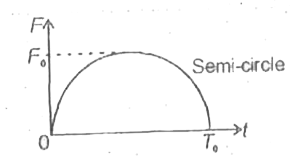Let ¯v(t) be the velocity of a particle al lime t. Then :
|d¯v(t)/dt|andd|¯v(t)|/dt∣are always equal
|d¯v(t)/dt|andd|¯v(t)|/dt∣,may always equal
|d¯v(t)/dt|can be zero whileandd|¯v(t)|/dt∣,is not zero
d|¯v(t)|/dt|≠0implies |d¯v(t)/dt∣≠0
The correct Answer is:B, C, D
To solve the problem regarding the relationship between the velocity of a particle and its derivatives, we need to analyze the options given and understand the mathematical implications of taking the modulus and the derivative.
1. Understanding Velocity and Derivatives:
- Let v(t) be the velocity of a particle at time t.
- The derivative of velocity with respect to time is given by dvdt, which represents acceleration.
2. Modulus of Velocity:
- The modulus of the velocity is denoted as |v(t)|. This means that all negative values of v(t) are turned into positive values.
3. Taking Derivatives:
- The derivative of the modulus of velocity with respect to time is d|v|dt.
- The key point here is that |v(t)| changes the sign of negative velocities, which affects the slope when we take the derivative.
4. Comparing the Two Derivatives:
- We need to compare ∣∣∣dvdt∣∣∣ and d|v|dt.
- If v(t) is negative, dvdt will also be negative, making ∣∣∣dvdt∣∣∣ positive.
- However, d|v|dt will be positive since we are taking the derivative of a positive value.
5. Analyzing the Options:
- Option A: States that ∣∣∣dvdt∣∣∣=d|v|dt is always true. This is incorrect because they can have different signs.
- Option B: Similar reasoning applies; it is incorrect.
- Option C: States that dvdt can be 0 while d|v|dt is not 0. This is also incorrect because if dvdt=0, then v(t) is constant, and thus |v(t)| would also not change.
- Option D: This option is correct as it states that ∣∣∣dvdt∣∣∣ and d|v|dt can be equal under certain conditions.
Conclusion:
From the analysis, we conclude that the correct relationship is that the modulus of the derivative of velocity can differ from the derivative of the modulus of velocity depending on the sign of the velocity.
- Let v(t) be the velocity of a particle at time t.
- The derivative of velocity with respect to time is given by dvdt, which represents acceleration.
- The modulus of the velocity is denoted as |v(t)|. This means that all negative values of v(t) are turned into positive values.
- The derivative of the modulus of velocity with respect to time is d|v|dt.
- The key point here is that |v(t)| changes the sign of negative velocities, which affects the slope when we take the derivative.
- We need to compare ∣∣∣dvdt∣∣∣ and d|v|dt.
- If v(t) is negative, dvdt will also be negative, making ∣∣∣dvdt∣∣∣ positive.
- However, d|v|dt will be positive since we are taking the derivative of a positive value.
- Option A: States that ∣∣∣dvdt∣∣∣=d|v|dt is always true. This is incorrect because they can have different signs.
- Option B: Similar reasoning applies; it is incorrect.
- Option C: States that dvdt can be 0 while d|v|dt is not 0. This is also incorrect because if dvdt=0, then v(t) is constant, and thus |v(t)| would also not change.
- Option D: This option is correct as it states that ∣∣∣dvdt∣∣∣ and d|v|dt can be equal under certain conditions.
From the analysis, we conclude that the correct relationship is that the modulus of the derivative of velocity can differ from the derivative of the modulus of velocity depending on the sign of the velocity.
Topper's Solved these Questions
- BOOK - ALLENCHAPTER - CIRCULAR MOTIONEXERCISE - Martrix match1videos
CIRCULAR MOTION
- BOOK - ALLENCHAPTER - CIRCULAR MOTIONEXERCISE - EXERCISE(O-2)7videos
CIRCULAR MOTION
- BOOK - ALLENCHAPTER - CIRCULAR MOTIONEXERCISE - EXERCISE(O-1)22videos
CIRCULAR MOTION
- BOOK - ALLENCHAPTER - BASIC MATHSEXERCISE - Question1videos
BASIC MATHS
- BOOK - ALLENCHAPTER - CURRENT ELECTRICITYEXERCISE - EX.II66videos
CURRENT ELECTRICITY
Similar Questions
The velocity of a particle is zero at t=0
View SolutionThe velocity of a particle is zero at time t = 2s, then
View SolutionPower supplied to a mass 2kg varies with time as P=3t22 watt. Here t is in second . If velocity of particle at t=0isv=0, the velocity of particle at time t=2s will be:
View SolutionThe velocity time relation of a particle is given by v =(3t2−2t−1)m/s Calculate the position and acceleration of the particle when velocity of the particle is zero . Given the initial position of the particle is 5m .
View SolutionThe coordinates of a particle moving in x-y plane at any time t are (2t,t2). Find (a) the trajectory of the particle, (b) velocity of particle at time t and (c) acceleration of particle at any time t.
View SolutionStarting from rest, the acceleration of a particle is a=2(t-1). The velocity of the particle at t=5s is :-
View SolutionA nucleus moving with velocity ¯v emits an α-particle. Let the velocities of the α-particle and the remaining nucleus be ¯v1 and ¯v2 and their masses be m1 and (m2) then,
View SolutionA nucleus moving with velocity ¯v emits an α-particle. Let the velocities of the α-particle and the remaining nucleus be ¯v1 and ¯v2 and their masses be m1 and (m2) then,
View SolutionThe magnitude of force acting on a particle moving along x-axis varies with time (t) as shown in figure. If at t = 0 the velocity of particle is v0, then its velocity at t=T0 will be
 View Solution
View SolutionA particle moves along the x-direction with constant acceleration. The displacement, measured from a convenient position, is 2 m at time t=0 and is zero when t=10s. If the velocity of the particle is momentary zero when t=6s, determine the acceleration a and the velocity v when t=10s.
View Solution

